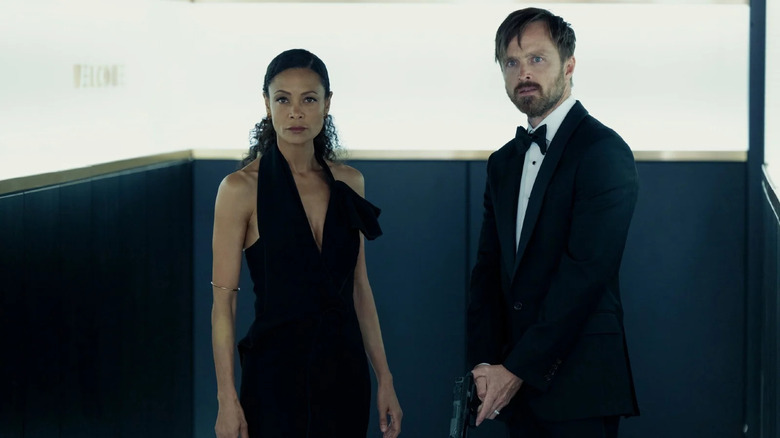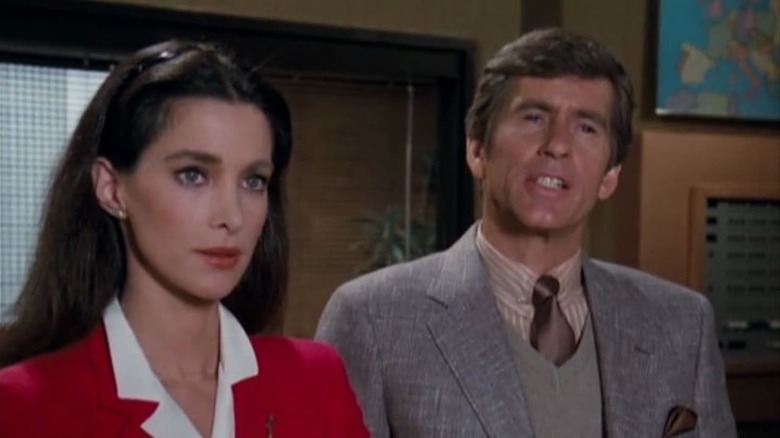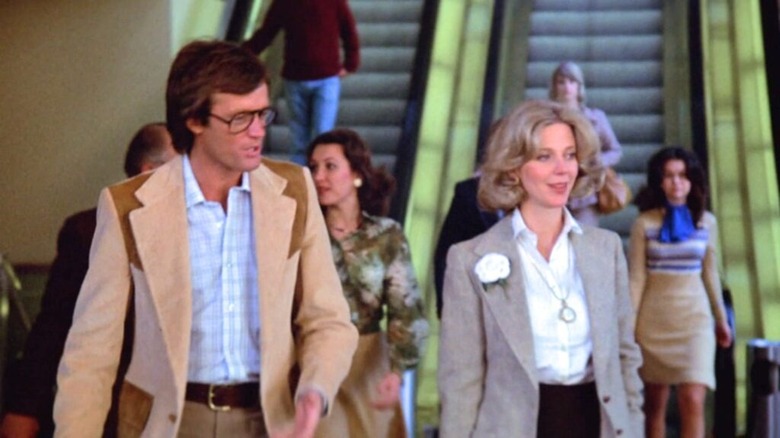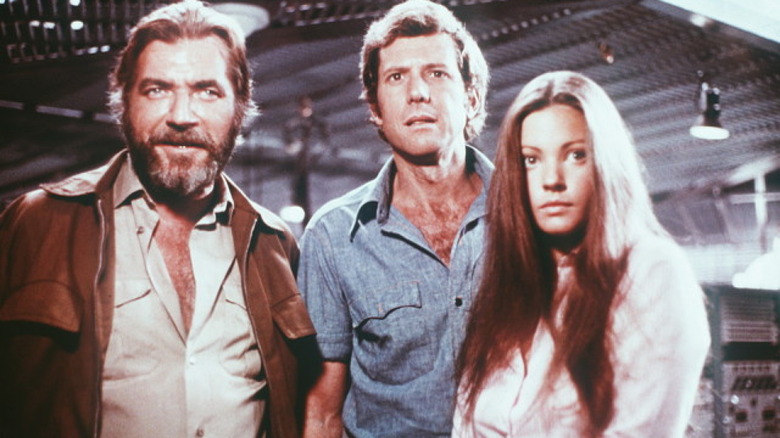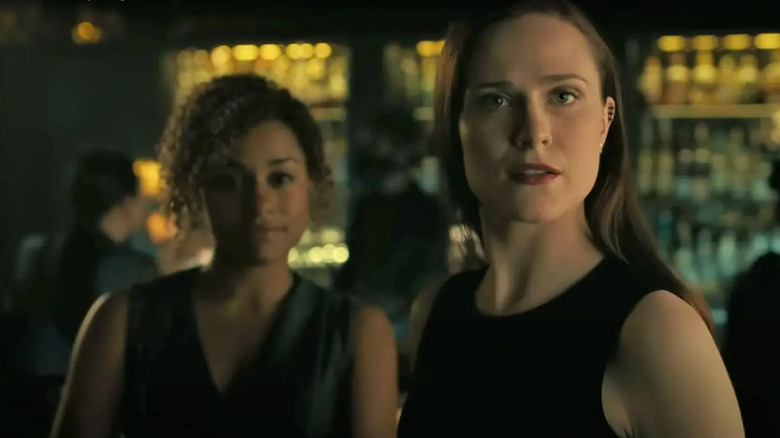How Westworld Season 4 Is Borrowing From The Franchise's Long, Bizarre Past
Michael Crichton's 1973 film "Westworld," for all its world-building and thematic complexity, is a simple story at its core. Its structure of a guest attending the titular resort where robot facsimiles of people programmed to fulfill the guest's every whim go haywire and start murdering the humans around them is as direct as a slasher movie, and with its technophobia combined with cynicism about humanity skirting responsibility for its actions, it can even be called quintessential Crichton.
HBO's "Westworld" series, however, is a far more complex work. Creators and showrunners Lisa Joy and Jonathan Nolan have a taste for playing devious games with their audience as much as the characters in the series do with each other. One need look no further than the recently aired fourth episode of season 4, which among its many twists revealed that the first few episodes of the season were not just intercutting between different characters, but different timelines. It's a sneaky trick the show has pulled before, and by this point it's clear Joy and Nolan have made obfuscation and sleight of hand a mainstay of the series.
Yet for all the new characters and ideas "Westworld" the series has dived into, the show continually demonstrates a dedication to mining its source material. In the fourth season alone, the show is drawing inspiration from not just the '73 feature, but the film's sequel (1976's "Futureworld"), a failed 1980 TV series ("Beyond Westworld") and even other works related to the creators of "Westworld."
Beyond Westworld provides a loose template for the first half of Westworld season 4
Airing for just a few weeks on CBS in 1980 with a scant five episodes, "Beyond Westworld" was a failed attempt to serialize the "Westworld" concept. Its place in the continuity of the films was ambiguous from the start, seemingly retconning the events of the first film from being the result of an advanced computer virus to the dastardly deeds of an evil scientist, Simon Quaid (James Wainwright). The series then followed Delos employees John Moore (Jim McMullan) and Pamela Williams (Connie Sellecca) as they attempted to thwart Quaid's plans to take over the world using robot sleeper agents in key positions.
While robot "hosts" not knowing they're really hosts has been a staple of HBO's "Westworld" from the first season, it's in the first few episodes of season 4 where the host version of Charlotte Hale/Dolores (Tessa Thompson) is seen explicitly using sleeper agent hosts to do her bidding, positioning themselves to best achieve her goal: turning the bulk of humanity into programmable and controllable beings, flipping the script and allowing the robot slaves to be the new masters. It's a plan Quaid wouldn't have the vision for in "Beyond Westworld," and the host Maeve (Thandiwe Newton) and human Caleb (Aaron Paul) are a far more dynamic pair of investigative heroes than John and Pamela.
Futureworld expanded the Westworld concept, laying the groundwork for the series
Of course, Charlotte Hale's sleeper hosts in "Westworld" season 4 aren't just any average people. Hale's plan involves replacing (or reprogramming via a parasite she's engineered within special flies who only attack humans) people of influence and authority. This is almost exactly the endgame of Dr. Morton Schneider (John Ryan) in 1976's "Futureworld."
"Futureworld," despite its flaws (such as a truly bizarre dream sequence that features the "return" of Yul Brynner's Gunslinger character from "Westworld"), is a movie that proved the "Westworld" universe had more stories in it besides technology run amok. In the film, written by Mayo Simon and George Schenck and directed by Richard T. Heffron, Delos has recovered from the "Westworld" disaster and now seeks to use a new version of the resort to lure important and influential people there so they can be scanned, murdered, and replaced with robots, the better for the corporation to literally own and run the world.
In fact, the same villainous plan has already been a part of the "Westworld" series, as seen in season 2, when it was revealed Delos had been secretly collecting and storing information on all its guests for future use. Where that information was first used against the world in the form of season 3's predictive supercomputer Rehoboam, it seems Hale is now using it (or a version of it) as originally intended, to replace and/or control the population.
Westworld season 4's flies have a possible ancestor in the ants of Phase IV
The "Westworld" series' influences aren't limited to the various spinoffs and sequels to the original film, however. Prior seasons have pulled from a variety of source material for plotlines and visual references, from the works of author Philip K. Dick to the films of Sergio Leone to the "Grand Theft Auto" games, as mentioned in this 2016 New Yorker interview with Christopher Nolan and Lisa Joy.
While the writers haven't confirmed it, season 4's parasite-ridden flies — themselves a clever callback to the inciting incident of the series — may be partially inspired by the 1974 film "Phase IV." The movie — the only to be directed by prolific graphic designer Saul Bass — concerns a pair of scientists investigating a mysterious evolution of the planet's ant population, with the insects building enigmatic structures and attempting to communicate some message while manipulating events toward some unknown goal.
Although the ending of the film is left highly ambiguous, it seems the newly evolved ants are attempting to evolve humanity, too — if they want to accept being changed, that is. Bass' original ending contained a surrealistic sequence in which human beings who seemingly refuse such evolution are reduced to being programmed and experimented on, turned into slaves much like Hale's human victims. In any case, not only are the agents of transformation in "Phase IV" and "Westworld" season 4 both insects, but the screenwriter of "Phase IV" is Mayo Simon, co-writer of "Futureworld."
The future of Westworld may still lie in the past
One theme of the "Westworld" series involves humans and hosts stuck in "loops," whether referring to their personalities allowing them to repeat the same mistakes, or history at large repeating itself. It's no surprise to realize the future of the show will likely involve elements from the past, whether it's directly tied to the "Westworld" universe or not.
Fans have name-checked "Futureworld" in their theories before, especially during the second season. At the start of season 4, "Futureworld" made a resurgence on Reddit, with people speculating that the woman known as Christina (Evan Rachel Wood) is secretly living in another park that's meant to emulate a future time period, as in the '76 film.
The fourth episode of season 4 somewhat confirms this, albeit with a nasty twist: Christina's world isn't a Delos park for human guests, but a cage for hapless human beings who've been transformed by Hale's flies and kept under her control. As the first episode of the season hinted at, Hale likely allows free-thinking hosts to visit the city as a similar tourist destination. In this way, this new primary time period for the series is simultaneously "Futureworld" and the plans of its villains made manifest, a future where the world is under the control of the powerful who have access to whatever and whoever they want.
Who knows where the back half of season 4 will take "Westworld" — elements of "Mad Max" and "Matrix" films are in place, with a conflict brewing between a scrappy resistance force and Hale's controlling forces. We'll find out soon enough, but if you're impatient, check out "Futureworld," "Phase IV" or "Beyond Westworld" for potential clues.
Investigate 1996's "Westworld 2000" first-person shooter computer game (complete with FMV!) at your own risk, however.
